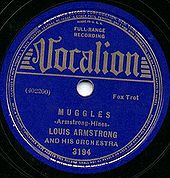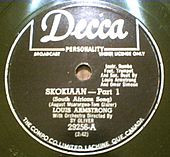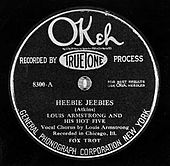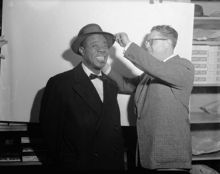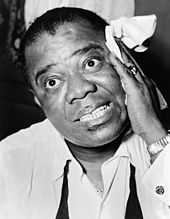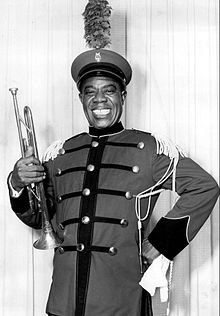
Louis Armstrong
Did you know...
This wikipedia selection has been chosen by volunteers helping SOS Children from Wikipedia for this Wikipedia Selection for schools. All children available for child sponsorship from SOS Children are looked after in a family home by the charity. Read more...
| Louis Armstrong | |
|---|---|
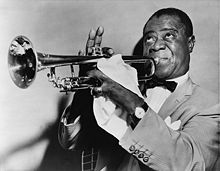 Louis Armstrong's stage personality matched his flashy cornet and trumpet playing. Armstrong is also known for his raspy singing voice. |
|
| Background information | |
| Born | August 4, 1901 New Orleans, Louisiana, U.S. |
| Died | July 6, 1971 (aged 69) Corona, Queens, New York City, U.S. |
| Genres | Dixieland, jazz, swing, traditional pop |
| Occupations | Musician |
| Instruments | trumpet, cornet, vocals |
| Years active | c. 1914–1971 |
| Associated acts | Joe "King" Oliver, Ella Fitzgerald, Kid Ory |
Louis Armstrong (August 4, 1901 – July 6, 1971), nicknamed Satchmo or Pops, was an American jazz trumpeter and singer from New Orleans, Louisiana.
Coming to prominence in the 1920s as an "inventive" trumpet and cornet player, Armstrong was a foundational influence in jazz, shifting the focus of the music from collective improvisation to solo performance. With his instantly-recognizable gravelly voice, Armstrong was also an influential singer, demonstrating great dexterity as an improviser, bending the lyrics and melody of a song for expressive purposes. He was also skilled at scat singing (vocalizing using sounds and syllables instead of actual lyrics).
Renowned for his charismatic stage presence and voice almost as much as for his trumpet-playing, Armstrong's influence extends well beyond jazz music, and by the end of his career in the 1960s, he was widely regarded as a profound influence on popular music in general. Armstrong was one of the first truly popular African-American entertainers to "cross over", whose skin-colour was secondary to his music in an America that was severely racially divided. He rarely publicly politicized his race, often to the dismay of fellow African-Americans, but took a well-publicized stand for desegregation during the Little Rock Crisis. His artistry and personality allowed him socially acceptable access to the upper echelons of American society that were highly restricted for a black man.
Early life
Armstrong often stated that he was born on July 4, 1900, a date that has been noted in many biographies. Although he died in 1971, it was not until the mid-1980s that his true birth date of August 4, 1901 was discovered by researcher Tad Jones through the examination of baptismal records. Armstrong was born into a very poor family in New Orleans, Louisiana, the grandson of slaves. He spent his youth in poverty, in a rough neighbourhood of Uptown New Orleans, known as “Back of the Town”, as his father, William Armstrong (1881–1922), abandoned the family when Louis was an infant and took up with another woman. His mother, Mary "Mayann" Albert (1886–1942), then left Louis and his younger sister Beatrice Armstrong Collins (1903–1987) in the care of his grandmother, Josephine Armstrong, and at times, his Uncle Isaac. At five, he moved back to live with his mother and her relatives, and saw his father only in parades.
He attended the Fisk School for Boys, where he likely had early exposure to music. He brought in some money as a paperboy and also by finding discarded food and selling it to restaurants, but it was not enough to keep his mother from prostitution. He hung out in dance halls close to home, where he observed everything from licentious dancing to the quadrille. For extra money he also hauled coal to Storyville, the famed red-light district, and listened to the bands playing in the brothels and dance halls, especially Pete Lala's where Joe "King" Oliver performed and other famous musicians would drop in to jam.
After dropping out of the Fisk School at age eleven, Armstrong joined a quartet of boys who sang in the streets for money. But he also started to get into trouble. Cornet player Bunk Johnson said he taught Armstrong (then 11) to play by ear at Dago Tony's Tonk in New Orleans, although in his later years Armstrong gave the credit to Oliver. Armstrong hardly looked back at his youth as the worst of times but instead drew inspiration from it, “Every time I close my eyes blowing that trumpet of mine—I look right in the heart of good old New Orleans... It has given me something to live for.”
He also worked for a Lithuanian-Jewish immigrant family, the Karnofskys, who had a junk hauling business and gave him odd jobs. They took him in and treated him as almost a family member, knowing he lived without a father, and would feed and nurture him. He later wrote a memoir of his relationship with the Karnofskys titled, Louis Armstrong + the Jewish Family in New Orleans, La., the Year of 1907. In it he describes his discovery that this family was also subject to discrimination by "other white folks' nationalities who felt that they were better than the Jewish race... I was only seven years old but I could easily see the ungodly treatment that the White Folks were handing the poor Jewish family whom I worked for." Armstrong wore a Star of David pendant for the rest of his life and wrote about what he learned from them: "how to live—real life and determination." The influence of Karnofsky is remembered in New Orleans by the Karnofsky Project, a non-profit organization dedicated to accepting donated musical instruments to "put them into the hands of an eager child who could not otherwise take part in a wonderful learning experience."
Armstrong developed his cornet playing seriously in the band of the New Orleans Home for Colored Waifs, where he had been sent multiple times for general delinquency, most notably for a long term after firing his stepfather's pistol into the air at a New Year's Eve celebration, as police records confirm. Professor Peter Davis (who frequently appeared at the Home at the request of its administrator, Captain Joseph Jones) instilled discipline in and provided musical training to the otherwise self-taught Armstrong. Eventually, Davis made Armstrong the band leader. The Home band played around New Orleans and the thirteen-year-old Louis began to draw attention by his cornet playing, starting him on a musical career. At fourteen he was released from the Home, living again with his father and new stepmother and then back with his mother and also back to the streets and their temptations. Armstrong got his first dance hall job at Henry Ponce’s where Black Benny became his protector and guide. He hauled coal by day and played his cornet at night.
He played in the city's frequent brass band parades and listened to older musicians every chance he got, learning from Bunk Johnson, Buddy Petit, Kid Ory, and above all, Joe "King" Oliver, who acted as a mentor and father figure to the young musician. Later, he played in the brass bands and riverboats of New Orleans, and began traveling with the well-regarded band of Fate Marable, which toured on a steamboat up and down the Mississippi River. He described his time with Marable as, "going to the University," since it gave him a much wider experience working with written arrangements.
In 1919, Joe Oliver decided to go north and resigned his position in Kid Ory's band; Armstrong replaced him. He also became second trumpet for the Tuxedo Brass Band, a society band.
Career
On March 19, 1918, Louis married Daisy Parker from Gretna, Louisiana. They adopted a 3-year-old boy, Clarence Armstrong, whose mother, Louis' cousin Flora, died soon after giving birth. Clarence Armstrong was mentally disabled (the result of a head injury at an early age) and Louis would spend the rest of his life taking care of him. Louis' marriage to Parker failed quickly and they separated. She died shortly after the divorce.
Through all his riverboat experience Armstrong’s musicianship began to mature and expand. At twenty, he could read music and he started to be featured in extended trumpet solos, one of the first jazzmen to do this, injecting his own personality and style into his solo turns. He had learned how to create a unique sound and also started using singing and patter in his performances. In 1922, Armstrong joined the exodus to Chicago, where he had been invited by his mentor, Joe "King" Oliver, to join his Creole Jazz Band and where he could make a sufficient income so that he no longer needed to supplement his music with day labor jobs. It was a boom time in Chicago and though race relations were poor, the “Windy City” was teeming with jobs for black people, who were making good wages in factories and had plenty to spend on entertainment.
Oliver's band was the best and most influential hot jazz band in Chicago in the early 1920s, at a time when Chicago was the centre of the jazz universe. Armstrong lived like a king in Chicago, in his own apartment with his own private bath (his first). Excited as he was to be in Chicago, he began his career-long pastime of writing nostalgic letters to friends in New Orleans. As Armstrong’s reputation grew, he was challenged to “cutting contests” by hornmen trying to displace the new phenom, who could blow two hundred high C’s in a row. Armstrong made his first recordings on the Gennett and Okeh labels (jazz records were starting to boom across the country), including taking some solos and breaks, while playing second cornet in Oliver's band in 1923. At this time, he met Hoagy Carmichael (with whom he would collaborate later) who was introduced by friend Bix Beiderbecke, who now had his own Chicago band.
Armstrong enjoyed working with Oliver, but Louis' second wife, pianist Lil Hardin Armstrong, urged him to seek more prominent billing and develop his newer style away from the influence of Oliver. Armstrong took the advice of his wife and left Oliver's band. For a year Armstrong played in Fletcher Henderson's band in New York on many recordings. After playing in New York, Armstrong returned to Chicago, playing in large orchestras; there he created his most important early recordings. Lil had her husband play classical music in church concerts to broaden his skill and improve his solo play and she prodded him into wearing more stylish attire to make him look sharp and to better offset his growing girth. Lil’s influence eventually undermined Armstrong’s relationship with his mentor, especially concerning his salary and additional moneys that Oliver held back from Armstrong and other band members. Armstrong and Oliver parted amicably in 1924. Shortly afterward, Armstrong received an invitation to go to New York City to play with the Fletcher Henderson Orchestra, the top African-American band of the day. Armstrong switched to the trumpet to blend in better with the other musicians in his section. His influence upon Henderson's tenor sax soloist, Coleman Hawkins, can be judged by listening to the records made by the band during this period.
Armstrong quickly adapted to the more tightly controlled style of Henderson, playing trumpet and even experimenting with the trombone and the other members quickly took up Armstrong’s emotional, expressive pulse. Soon his act included singing and telling tales of New Orleans characters, especially preachers. The Henderson Orchestra was playing in the best venues for white-only patrons, including the famed Roseland Ballroom, featuring the classy arrangements of Don Redman. Duke Ellington’s orchestra would go to Roseland to catch Armstrong’s performances and young hornmen around town tried in vain to outplay him, splitting their lips in their attempts.
During this time, Armstrong made many recordings on the side, arranged by an old friend from New Orleans, pianist Clarence Williams; these included small jazz band sides with the Williams Blue Five (some of the best pairing Armstrong with one of Armstrong's few rivals in fiery technique and ideas, Sidney Bechet) and a series of accompaniments with blues singers, including Bessie Smith, Ma Rainey, and Alberta Hunter.
Armstrong returned to Chicago in 1925 due mostly to the urging of his wife, who wanted to pump up Armstrong’s career and income. He was content in New York but later would concede that she was right and that the Henderson Orchestra was limiting his artistic growth. In publicity, much to his chagrin, she billed him as “the World’s Greatest Trumpet Player”. At first, he was actually a member of the Lil Hardin Armstrong Band and working for his wife. He began recording under his own name for Okeh with his famous Hot Five and Hot Seven groups, producing hits such as " Potato Head Blues", " Muggles", (a reference to marijuana, for which Armstrong had a lifelong fondness), and " West End Blues", the music of which set the standard and the agenda for jazz for many years to come.
The group included Kid Ory (trombone), Johnny Dodds (clarinet), Johnny St. Cyr (banjo), wife Lil on piano, and usually no drummer. Armstrong’s bandleading style was easygoing, as St. Cyr noted, "One felt so relaxed working with him, and he was very broad-minded . . . always did his best to feature each individual." His recordings soon after with pianist Earl "Fatha" Hines (most famously their 1928 Weatherbird duet) and Armstrong's trumpet introduction to "West End Blues" remain some of the most famous and influential improvisations in jazz history. Armstrong was now free to develop his personal style as he wished, which included a heavy dose of effervescent jive, such as "whip that thing, Miss Lil" and "Mr. Johnny Dodds, Aw, do that clarinet, boy!"
Armstrong also played with Erskine Tate’s Little Symphony, actually a quintet, which played mostly at the Vendome Theatre. They furnished music for silent movies and live shows, including jazz versions of classical music, such as "Madame Butterfly," which gave Armstrong experience with longer forms of music and with hosting before a large audience. He began to scat sing (improvised vocal jazz using non-sensical words) and was among the first to record it, on " Heebie Jeebies" in 1926. The recording was so popular that the group became the most famous jazz band in the United States, even though they had not performed live to any great extent. Young musicians across the country, black or white, were turned on by Armstrong’s new type of jazz.
After separating from Lil, Armstrong started to play at the Sunset Café for Al Capone's associate Joe Glaser in the Carroll Dickerson Orchestra, with Earl Hines on piano, which was soon renamed Louis Armstrong and his Stompers, though Hines was the music director and Glaser managed the orchestra. Hines and Armstrong became fast friends as well as successful collaborators.
Armstrong returned to New York, in 1929, where he played in the pit orchestra of the successful musical Hot Chocolate, an all-black revue written by Andy Razaf and pianist/composer Fats Waller. He also made a cameo appearance as a vocalist, regularly stealing the show with his rendition of " Ain't Misbehavin'", his version of the song becoming his biggest selling record to date.
Armstrong started to work at Connie's Inn in Harlem, chief rival to the Cotton Club, a venue for elaborately staged floor shows, and a front for gangster Dutch Schultz. Armstrong also had considerable success with vocal recordings, including versions of famous songs composed by his old friend Hoagy Carmichael. His 1930s recordings took full advantage of the new RCA ribbon microphone, introduced in 1931, which imparted a characteristic warmth to vocals and immediately became an intrinsic part of the ' crooning' sound of artists like Bing Crosby. Armstrong's famous interpretation of Hoagy Carmichael's " Stardust" became one of the most successful versions of this song ever recorded, showcasing Armstrong's unique vocal sound and style and his innovative approach to singing songs that had already become standards.
Armstrong's radical re-working of Sidney Arodin and Carmichael's " Lazy River" (recorded in 1931) encapsulated many features of his groundbreaking approach to melody and phrasing. The song begins with a brief trumpet solo, then the main melody is stated by sobbing horns, memorably punctuated by Armstrong's growling interjections at the end of each bar: "Yeah! ..."Uh-huh" ..."Sure" ... "Way down, way down." In the first verse, he ignores the notated melody entirely and sings as if playing a trumpet solo, pitching most of the first line on a single note and using strongly syncopated phrasing. In the second stanza he breaks into an almost fully improvised melody, which then evolves into a classic passage of Armstrong " scat singing".
As with his trumpet playing, Armstrong's vocal innovations served as a foundation stone for the art of jazz vocal interpretation. The uniquely gritty coloration of his voice became a musical archetype that was much imitated and endlessly impersonated. His scat singing style was enriched by his matchless experience as a trumpet soloist. His resonant, velvety lower-register tone and bubbling cadences on sides such as "Lazy River" exerted a huge influence on younger white singers such as Bing Crosby.
The Depression of the early Thirties was especially hard on the jazz scene. The Cotton Club closed in 1936 after a long downward spiral, and many musicians stopped playing altogether as club dates evaporated. Bix Beiderbecke died and Fletcher Henderson’s band broke up. King Oliver made a few records but otherwise struggled. Sidney Bechet became a tailor and Kid Ory returned to New Orleans and raised chickens.
Armstrong moved to Los Angeles in 1930 to seek new opportunities. He played at the New Cotton Club in Los Angeles with Lionel Hampton on drums. The band drew the Hollywood crowd, which could still afford a lavish night life, while radio broadcasts from the club connected with younger audiences at home. Bing Crosby and many other celebrities were regulars at the club. In 1931, Armstrong appeared in his first movie, Ex-Flame. Armstrong was convicted of marijuana possession but received a suspended sentence. He returned to Chicago in late 1931 and played in bands more in the Guy Lombardo vein and he recorded more standards. When the mob insisted that he get out of town, Armstrong visited New Orleans, got a hero’s welcome and saw old friends. He sponsored a local baseball team known as “Armstrong’s Secret Nine” and got a cigar named after himself. But soon he was on the road again and after a tour across the country shadowed by the mob, Armstrong decided to go to Europe to escape.
After returning to the United States, he undertook several exhausting tours. His agent Johnny Collins’ erratic behaviour and his own spending ways left Armstrong short of cash. Breach of contract violations plagued him. Finally, he hired Joe Glaser as his new manager, a tough mob-connected wheeler-dealer, who began to straighten out his legal mess, his mob troubles, and his debts. Armstrong also began to experience problems with his fingers and lips, which were aggravated by his unorthodox playing style. As a result he branched out, developing his vocal style and making his first theatrical appearances. He appeared in movies again, including Crosby's 1936 hit Pennies from Heaven. In 1937, Armstrong substituted for Rudy Vallee on the CBS radio network and became the first African American to host a sponsored, national broadcast. He finally divorced Lil in 1938 and married longtime girlfriend Alpha.
After spending many years on the road, Armstrong settled permanently in Queens, New York in 1943 in contentment with his fourth wife, Lucille. Although subject to the vicissitudes of Tin Pan Alley and the gangster-ridden music business, as well as anti-black prejudice, he continued to develop his playing. He recorded Hoagy Carmichael's Rockin' Chair for Okeh Records.
During the subsequent thirty years, Armstrong played more than three hundred gigs a year. Bookings for big bands tapered off during the 1940s due to changes in public tastes: ballrooms closed, and there was competition from television and from other types of music becoming more popular than big band music. It became impossible under such circumstances to support and finance a 16-piece touring band.
The All Stars
Following a highly successful small-group jazz concert at New York Town Hall on May 17, 1947, featuring Armstrong with trombonist/singer Jack Teagarden, Armstrong's manager Joe Glaser dissolved the Armstrong big band on August 13, 1947 and established a six-piece small group featuring Armstrong with (initially) Teagarden, Earl Hines and other top swing and dixieland musicians, most of them ex-big band leaders. The new group was announced at the opening of Billy Berg's Supper Club.
This group was called Louis Armstrong and his All Stars and included at various times Earl "Fatha" Hines, Barney Bigard, Edmond Hall, Jack Teagarden, Trummy Young, Arvell Shaw, Billy Kyle, Marty Napoleon, Big Sid Catlett, Cozy Cole, Tyree Glenn, Barrett Deems, Joe Darensbourg and the Filipino-American percussionist, Danny Barcelona. During this period, Armstrong made many recordings and appeared in over thirty films. He was the first jazz musician to appear on the cover of Time Magazine on February 21, 1949.
In 1964, he recorded his biggest-selling record, " Hello, Dolly!" The song went to No. 1 on the pop chart, making Armstrong (age 63) the oldest person to ever accomplish that feat. In the process, Armstrong dislodged The Beatles from the No. 1 position they had occupied for 14 consecutive weeks with three different songs.
Armstrong kept up his busy tour schedule until a few years before his death in 1971. In his later years he would sometimes play some of his numerous gigs by rote, but other times would enliven the most mundane gig with his vigorous playing, often to the astonishment of his band. He also toured Africa, Europe, and Asia under sponsorship of the US State Department with great success, earning the nickname "Ambassador Satch." While failing health restricted his schedule in his last years, within those limitations he continued playing until the day he died.
Death
Armstrong died of a heart attack in his sleep on July 6, 1971, a month before his 70th birthday, and 11 months after playing a famous show at the Waldorf-Astoria's Empire Room. He was residing in Corona, Queens, New York City, at the time of his death. He was interred in Flushing Cemetery, Flushing, in Queens, New York City. His honorary pallbearers included Bing Crosby, Ella Fitzgerald, Dizzy Gillespie, Pearl Bailey, Count Basie, Harry James, Frank Sinatra, Ed Sullivan, Earl Wilson, Alan King, Johnny Carson and David Frost. Peggy Lee sang The Lord's Prayer at the services while Al Hibbler sang " Nobody Knows the Trouble I've Seen" and Fred Robbins, a long-time friend, gave the eulogy.
Music
Horn playing and early jazz
In his early years, Armstrong was best known for his virtuosity with the cornet and trumpet. The greatest trumpet playing of his early years can be heard on his Hot Five and Hot Seven records, as well as the Red Onion Jazz Babies. The improvisations he made on these records of New Orleans jazz standards and popular songs of the day are unsurpassed by later jazz performers. The older generation of New Orleans jazz musicians often referred to their improvisations as "variating the melody." Armstrong's improvisations were daring and sophisticated for the time, while often subtle and melodic.
He often essentially re-composed pop-tunes he played, making them more interesting. Armstrong's playing is filled with joyous, inspired original melodies, creative leaps, and subtle relaxed or driving rhythms. The genius of these creative passages is matched by Armstrong's playing technique, honed by constant practice, which extended the range, tone and capabilities of the trumpet. In these records, Armstrong almost single-handedly created the role of the jazz soloist, taking what was essentially a collective folk music and turning it into an art form with tremendous possibilities for individual expression.
Armstrong's work in the 1920s shows him playing at the outer limits of his abilities. The Hot Five records, especially, often have minor flubs and missed notes, which do little to detract from listening enjoyment since the energy of the spontaneous performance comes through. By the mid-1930s, Armstrong achieved a smooth assurance, knowing exactly what he could do and carrying out his ideas to perfection.
He was one of the first artists to use recordings of his performances to improve himself. Armstrong was an avid audiophile. He had a large collection of recordings, including reel-to-reel tapes, which he took on the road with him in a trunk during his later career. He enjoyed listening to his own recordings, and comparing his performances musically. In the den of his home, he had the latest audio equipment and would sometimes rehearse and record along with his older recordings or the radio.
Vocal popularity
As his music progressed and popularity grew, his singing also became very important. Armstrong was not the first to record scat singing, but he was masterful at it and helped popularize it. He had a hit with his playing and scat singing on " Heebie Jeebies" when, according to some legends, the sheet music fell on the floor and he simply started singing nonsense syllables. Armstrong stated in his memoirs that this actually occurred. He also sang out "I done forgot the words" in the middle of recording "I'm A Ding Dong Daddy From Dumas."
Such records were hits and scat singing became a major part of his performances. Long before this, however, Armstrong was playing around with his vocals, shortening and lengthening phrases, interjecting improvisations, using his voice as creatively as his trumpet.
Colleagues and followers
During his long career he played and sang with some of the most important instrumentalists and vocalists of the time; among them were Bing Crosby, Duke Ellington, Fletcher Henderson, Earl Hines, the singing brakeman Jimmie Rodgers, Bessie Smith and perhaps most famously Ella Fitzgerald.
His influence upon Bing Crosby is particularly important with regard to the subsequent development of popular music: Crosby admired and copied Armstrong, as is evident on many of his early recordings, notably "Just One More Chance" (1931). The New Grove Dictionary Of Jazz describes Crosby's debt to Armstrong in precise detail, although it does not acknowledge Armstrong by name:
Crosby... was important in introducing into the mainstream of popular singing an Afro-American concept of song as a lyrical extension of speech... His techniques—easing the weight of the breath on the vocal cords, passing into a head voice at a low register, using forward production to aid distinct enunciation, singing on consonants (a practice of black singers), and making discreet use of appoggiaturas, mordents, and slurs to emphasize the text—were emulated by nearly all later popular singers.
Armstrong recorded three albums with Ella Fitzgerald: Ella and Louis, Ella and Louis Again, and Porgy and Bess for Verve Records, with the sessions featuring the backing musicianship of the Oscar Peterson Trio and drummer Buddy Rich. His recordings Satch Plays Fats, all Fats Waller tunes, and Louis Armstrong Plays W.C. Handy in the 1950s were perhaps among the last of his great creative recordings, but even oddities like Disney Songs the Satchmo Way are seen to have their musical moments. And, his participation in Dave Brubeck's high-concept jazz musical The Real Ambassadors was critically acclaimed. For the most part, however, his later output was criticized as being overly simplistic or repetitive.
Hits and later career
Armstrong had many hit records including " Stardust", " What a Wonderful World", " When The Saints Go Marching In", " Dream a Little Dream of Me", " Ain't Misbehavin'", "You Rascal You,"and "Stompin' at the Savoy." " We Have All the Time in the World" was featured on the soundtrack of the James Bond film On Her Majesty's Secret Service, and enjoyed renewed popularity in the UK in 1994 when it featured on a Guinness advert. It reached number 3 in the charts on being re-released.
In 1964, Armstrong knocked The Beatles off the top of the Billboard Hot 100 chart with " Hello, Dolly!", which gave the 63-year-old performer a U.S. record as the oldest artist to have a number one song. His 1964 song "Bout Time" was later featured in the film Bewitched.
Armstrong performed in Italy at the 1968 Sanremo Music Festival where he sang "Mi Va di Cantare" alongside his friend, the Eritrean-born Italian singer Lara Saint Paul. In February 1968, he also appeared with Lara Saint Paul on the Italian RAI television channel where he performed "Grassa e Bella," a track he sang in Italian for the Italian market and C.D.I. label.
In 1968, Armstrong scored one last popular hit in the United Kingdom with the highly sentimental pop song " What a Wonderful World", which topped the British charts for a month; however, the single did not chart at all in America. The song gained greater currency in the popular consciousness when it was used in the 1987 movie Good Morning, Vietnam, its subsequent re-release topping many charts around the world. Armstrong even appeared on the October 28, 1970, Johnny Cash Show, where he sang Nat King Cole's hit " Rambling Rose" and joined Cash to re-create his performance backing Jimmie Rodgers on " Blue Yodel No. 9".
Stylistic range
Armstrong enjoyed many types of music, from blues to the arrangements of Guy Lombardo, to Latin American folksongs, to classical symphonies and opera. Armstrong incorporated influences from all these sources into his performances, sometimes to the bewilderment of fans who wanted him to stay in convenient narrow categories. Armstrong was inducted into Rock and Roll Hall of Fame as an early influence. Some of his solos from the 1950s, such as the hard rocking version of " St. Louis Blues" from the WC Handy album, show that the influence went in both directions.
Literature, radio, films and TV
Armstrong appeared in more than a dozen Hollywood films, usually playing a band leader or musician. His most familiar role was as the bandleader cum narrator in the 1956 musical, High Society, in which he sang the title song and performed a duet with Bing Crosby on " Now You Has Jazz". In 1947, he played himself in the movie New Orleans opposite Billie Holiday, which chronicled the demise of the Storyville district and the ensuing exodus of musicians from New Orleans to Chicago. In the 1959 film, The Five Pennies (the story of the cornetist Red Nichols), Armstrong played himself as well as singing and playing several classic numbers. With Danny Kaye Armstrong performed a duet of "When the Saints Go Marching In" during which Kaye impersonated Armstrong. Armstrong also had a part in the film alongside James Stewart in The Glenn Miller Story in which Glenn (played by Stewart) jammed with Armstrong and a few other noted musicians of the time.
He was the first African American to host a nationally broadcast radio show in the 1930s. In 1969, Armstrong had a cameo role in the film version of Hello, Dolly! as the bandleader, Louis, to which he sang the title song with actress Barbra Streisand. His solo recording of " Hello, Dolly!" is one of his most recognizable performances.
He was heard on such radio programs as The Story of Swing (1937) and This Is Jazz (1947), and he also made countless television appearances, especially in the 1950s and 1960s, including appearances on The Tonight Show Starring Johnny Carson.
Many of Armstrong's recordings remain popular. Almost four decades since his passing, a larger number of his recordings from all periods of his career are more widely available than at any time during his lifetime. His songs are broadcast and listened to every day throughout the world, and are honored in various movies, TV series, commercials, and even anime and video games. " A Kiss to Build a Dream On" was included in the video game Fallout 2, accompanying the intro cinematic. It was also used in the 1993 film Sleepless in Seattle and the 2005 film Lord of War. His 1923 recordings, with Joe Oliver and his Creole Jazz Band, continue to be listened to as documents of ensemble style New Orleans jazz, but more particularly as ripper jazz records in their own right. All too often, however, Armstrong recorded with stiff, standard orchestras leaving only his sublime trumpet playing as of interest. "Melancholy Blues," performed by Armstrong and his Hot Seven was included on the Voyager Golden Record sent into outer space to represent one of the greatest achievements of humanity. Most familiar to modern listeners is his ubiquitous rendition of " What a Wonderful World". In 2008, Armstrong's recording of Edith Piaf's famous " La Vie En Rose" was used in a scene of the popular Disney/Pixar film WALL-E. The song was also used in parts, especially the opening trumpets, in the French film Jeux d'enfants (Love Me If You Dare.)
Argentine writer Julio Cortázar, a self-described Armstrong admirer, asserted that a 1952 Louis Armstrong concert at the Théâtre des Champs-Élysées in Paris played a significant role in inspiring him to create the fictional creatures called Cronopios that are the subject of a number of Cortázar's short stories. Cortázar once called Armstrong himself "Grandísimo Cronopio" (The Great Cronopio).
Armstrong appears as a minor fictionalized character in Harry Turtledove's Southern Victory Series. When he and his band escape from a Nazi-like Confederacy, they enhance the insipid mainstream music of the North. A young Armstrong also appears as a minor fictionalized character in Patrick Neate's 2001 novel Twelve Bar Blues, part of which is set in New Orleans, and which was a winner at that year's Whitbread Book Awards.
There is a pivotal scene in Stardust Memories (1980) in which Woody Allen is overwhelmed by a recording of Armstrong's " Stardust" and experiences a nostalgic epiphany. The combination of the music and the perfect moment is the catalyst for much of the film's action, prompting the protagonist to fall in love with an ill-advised woman.
Awards and honours
Grammy Awards
Armstrong was posthumously awarded the Grammy Lifetime Achievement Award in 1972 by the Academy of Recording Arts and Sciences. This Special Merit Award is presented by vote of the Recording Academy's National Trustees to performers who, during their lifetimes, have made creative contributions of outstanding artistic significance to the field of recording.
| Grammy Award | |||||
| Year | Category | Title | Genre | Label | Result |
|---|---|---|---|---|---|
| 1964 | Male Vocal Performance | " Hello, Dolly!" | Pop | Kapp | Winner |
Grammy Hall of Fame
Recordings of Armstrong were inducted into the Grammy Hall of Fame, which is a special Grammy award established in 1973 to honour recordings that are at least twenty-five years old, and that have "qualitative or historical significance."
| Grammy Hall of Fame | |||||
| Year recorded | Title | Genre | Label | Year inducted | Notes |
|---|---|---|---|---|---|
| 1929 | " St. Louis Blues" | Jazz (Single) | OKeh | 2008 | with Bessie Smith |
| 1928 | "Weather Bird" | Jazz (Single) | OKeh | 2008 | with Earl Hines |
| 1930 | " Blue Yodel No. 9 (Standing on the Corner)" |
Country (Single) | Victor | 2007 | Jimmie Rodgers (Featuring Louis Armstrong) |
| 1932 | " All of Me" | Jazz (Single) | Columbia | 2005 | |
| 1958 | Porgy and Bess | Jazz (Album) | Verve | 2001 | with Ella Fitzgerald |
| 1964 | " Hello Dolly!" | Pop (Single) | Kapp | 2001 | |
| 1926 | " Heebie Jeebies" | Jazz (Single) | OKeh | 1999 | |
| 1968 | " What a Wonderful World" | Jazz (Single) | ABC | 1999 | |
| 1955 | " Mack the Knife" | Jazz (Single) | Columbia | 1997 | |
| 1925 | " St. Louis Blues" | Jazz (Single) | Columbia | 1993 | Bessie Smith with Louis Armstrong, cornet |
| 1928 | " West End Blues" | Jazz (Single) | OKeh | 1974 | |
Rock and Roll Hall of Fame
The Rock and Roll Hall of Fame listed Armstrong's West End Blues on the list of 500 songs that shaped Rock and Roll.
| Year recorded | Title | Label | Group |
|---|---|---|---|
| 1928 | West End Blues | Okeh | Louis Armstrong and his Hot Five |
Inductions and honours
In 1995, the U.S. Post Office issued a Louis Armstrong 32 cents commemorative postage stamp.
| Year inducted | Title | Results | Notes |
|---|---|---|---|
| 2007 | Louisiana Music Hall of Fame | ||
| 2007 | Gennett Records Walk of Fame, Richmond, Indiana | ||
| 2007 | Long Island Music Hall of Fame | ||
| 2004 | Nesuhi Ertegün Jazz Hall of Fame at Jazz at Lincoln Centre |
||
| 1990 | Rock and Roll Hall of Fame | Early influence | |
| 1978 | Big Band and Jazz Hall of Fame | ||
| 1952 | Down Beat Jazz Hall of Fame | ||
| 1960 | Hollywood Walk of Fame | Star | at 7601 Hollywood Blvd. |
Legacy
The influence of Armstrong on the development of jazz is virtually immeasurable. Yet, his irrepressible personality both as a performer, and as a public figure later in his career, was so strong that to some it sometimes overshadowed his contributions as a musician and singer.
As a virtuoso trumpet player, Armstrong had a unique tone and an extraordinary talent for melodic improvisation. Through his playing, the trumpet emerged as a solo instrument in jazz and is used widely today. He was a masterful accompanist and ensemble player in addition to his extraordinary skills as a soloist. With his innovations, he raised the bar musically for all who came after him.
Though Armstrong is widely recognized as a pioneer of scat singing, Ethel Waters precedes his scatting on record in the 1930s according to Gary Giddins and others. Billie Holiday and Frank Sinatra are just two singers who were greatly indebted to him. Holiday said that she always wanted Bessie Smith's 'big' sound and Armstrong's feeling in her singing. Even special musicians like Duke Ellington have praised Armstrong through strong testimonials. Duke Ellington said, "If anybody was a master, it was Louis Armstrong." In 1950, Bing Crosby, the most successful vocalist of the first half of the 20th century, said, "He is the beginning and the end of music in America."
On August 4, 2001, the centennial of Armstrong's birth, New Orleans's airport was renamed Louis Armstrong International Airport in his honour.
In 2002, the Louis Armstrong's Hot Five and Hot Seven recordings (1925–1928) are preserved in the United States National Recording Registry, a registry of recordings selected yearly by the National Recording Preservation Board for preservation in the National Recording Registry of the Library of Congress.
The US Open tennis tournament's former main stadium was named Louis Armstrong Stadium in honour of Armstrong who had lived a few blocks from the site.
Today, there are many bands worldwide dedicated to preserving and honoring the music and style of Satchmo, including the Louis Armstrong Society located in New Orleans, LA.
House
The house where Louis Armstrong lived for close to 28 years was declared a National Historic Landmark in 1977 and is now a museum. The Louis Armstrong House Museum, at 34-56 107th Street (between 34th and 37th Avenues) in Corona, Queens, presents concerts and educational programs, operates as a historic house museum and makes materials in its archives of writings, books, recordings and memorabilia available to the public for research. The museum is operated by the City University of New York's Queens College, following the dictates of Lucille Armstrong's will.
The museum opened to the public on October 15, 2003. A new visitors centre is planned.
Discography
For complete listings, see Louis Armstrong's works by album or song:
- Louis Armstrong albums
- Louis Armstrong songs

